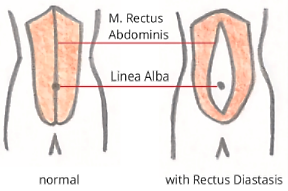What is a Diastasis Recti?
A Diastasis Recti is the separation of the outermost Abdominal Muscles (M. Rectus Abdominis).
Due to a pregnancy, incorrect workout or load in daily life, rapid weight gain or certain stomach surgeries, the connective tissue (Linea Alba) between the muscle bellies of the M. Rectus Abdominis are stretched.
Through the weakened and overstretched Linea Alba the muscle bellies of the M. Rectus Abdominis move away from each other – the gap that appears is called Diastasis Recti.

What are symptoms of a Diastasis Recti?
Explanation videos

Q&A Midwife Consulting Part 1 (DE)
We introduce you our Midwife BSc Lea Hungerbühler. Find out more about her background and the services she offers as part of StibahMidwife Consulting.

Q&A Midwife Consulting Part 2 (DE)
Our Midwife BSc Lea Hungerbühler will explain what exactly a Diastasis Recti is, who is affected and why the treatment of it is important.

Q&A Midwife Consulting Part 3 (DE)
Get more information in this video what the therapy is all about and what do you need to know about the correct abdominal breathing.
Tupler Technique®
Julie Tupler is a registered Nurse, certified Personal Trainer and Childbirth Educator. She developed the Tupler Technique® with which she successfully treat patients with a Diastasis Recti since 1990.
The success of the practice program of Julie Tupler was confirmed by a study of the Faculty of Physiotherapy at the Colombia University

The program
The program of the Tupler Technique® takes at least 6 weeks, depending the dimension of the Diastasis Recti and the condition of the connective tissue (Linea Alba).
The aim of the Tupler Technique® is to close the Diastasis Recti and to strengthen the connective tissue between the abdominal muscles.
This should be achieved through the 3 P:

position
The straight abdominal muscles (M. Rectus Abdominis) are positioned in their original place by the help of a abdominal belt (Diastasis Rehab Splint®) so they can work efficiently again.

protection
Through the repositioning of the straight abdominal muscles (M. Rectus Abdominis) by the help of the Splint, the connective tissue (Linea Alba) should be protected against expansion and overload in daily life as well as in training situations.

power
During the program the traverse abdominal muscle (M. Transversus Abdominis) will be strengthened targeted. With a strong M. Transversus Abdominis it is possible to keep closed permanently the Diastasis Recti and protect the Linea Alba.
